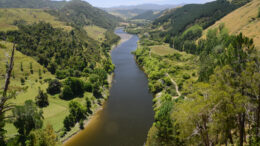In 2017, after more than a century of legal struggles by the Māori people of the Whanganui River (Te Āti Haunui-a-Pāpārangi), the 292-kilometer Whanganui River — also known as Te Awa Tupua — became the first river in the world to be recognized as a legal entity, granting it the same rights and powers as a legal person.
The passage of the Te Awa Tupua Act has been a milestone for Aotearoa New Zealand — a name that reflects the country’s Māori identity and colonial history. It has also been read as an encouraging example for the granting of legal personhood to ecosystems in other parts of the world.
While Whanganui personhood is a good news story, we must recognize that the path to Parliament’s passage of the Te Awa Tupua Act was entrenched in colonial dynamics. Māori Iwi of the Whanganui region have long had to advocate against an often conservative and Western-minded government structure. Their relentless advocacy efforts have shaped the narrative of Te Awa Tupua, a story rooted in the deep connection between culture, land, and water.
View this post on Instagram
The clash between Te Awa Tupua and Western legal frameworks, alongside Indigenous law, serves as the backdrop for continuing political and cultural dynamics. More recently, with the inauguration of Aotearoa New Zealand’s new coalition government led by conservative Christopher Luxon, these challenges have become more conspicuous.
We believe that the Te Awa Tupua Act should not only be read by law- and policymakers as a legal framework, but also as an inspiration for communities to embrace a leadership model entrenched in Tupua Te Kawa principles, the system of principles underpinning Te Awa Tupua.
A History Steeped in Colonialism
To understand the future of Te Awa Tupua, we must first understand its greater context.
The historical background to the recognition of Te Awa Tupua as a legal entity is deeply intertwined with the colonization of Aotearoa New Zealand by the British and the subsequent conflicts and wars in the 19th century.
Since 1873 Whanganui Iwi have sought recognition of their authority over the Whanganui River, including by pursuing one of New Zealand’s longest-running court cases, the Native Land Court application of 1938 contesting the ownership of the riverbed. The case was finally settled in favor of the Crown by the Court of Appeal in 1962. Given the colonial nature of Iwi-Crown (government) relationships, the Waitangi Tribunal was set up in 1975 as a standing commission of inquiry to make recommendations on claims brought by Māori relating to legislation, policies, actions, or omissions of the Crown that are alleged to breach the promises made in the Treaty of Waitangi. Ultimately, however, the tribunal has limited powers, especially in preventing treaty violations from happening.
View this post on Instagram
Ruruku Whakatupua, the Deed of Settlement for the Whanganui River (2014), is the culmination of more than a century of effort by Whanganui Iwi to protect and provide for the special relationship of Whanganui Iwi with the river. Ruruku Whakatupua settles the historical Treaty of Waitangi claims of Whanganui Iwi in relation to the river. While the Whanganui River Iwi view the river as a living being, it is in the context of a more-than-human being rather than a human person. The framing of the Te Awa Tupua Act as legislation concerning legal personhood is more for the appeasement and convenience of European sentiments than for the Māori.
The Te Awa Tupua Act
Te Awa Tupua is one of numerous cases in which a history of injustice exists. Its recognition as a legal entity is therefore a decisive event not only in the history of Aotearoa’s environmental legislation, but also in coming to terms with its own colonial past.
Te Awa Tupua is the longest navigable waterway in Aotearoa New Zealand. It has always been a source of sustenance, spiritual connectedness, and of course a main transport and trade route. There are numerous Māori tales that link the formation of the riverbed to a dispute between various North Island volcanoes. However, almost since the beginning of colonization, Te Awa Tupua has been abused. The destruction of eel weirs to make way for early riverboat service caused the loss of food sources for Whanganui Iwi. Furthermore, commercial forestry entities have planted all the way to the water line, and other irresponsible farming developments on marginal land have continually increased the sediment accumulation in the river and its tributaries. Since the 1970s a portion of the very upper reaches of the Whanganui River has been diverted and commercially developed to generate electricity. This has seriously affected the ability of the river to flush itself naturally.
In 2014 Māori communities and the Crown signed a deed of settlement regarding Te Awa Tupua. In 2017 a corresponding Act was approved by Parliament in which the river — including its physical and metaphysical elements — is recognized as having the “rights, powers, duties, and liabilities of a legal person.”
In the Act, Te Awa Tupua is assigned two legal representatives: one representing the Māori Iwi and another representing the government. They make up a committee given the name Te Pou Tupua — the human face of the river — and represents its interests. Te Pou Tupua is supported by an advisory group (Te Karewao) and a strategy group (Te Kōpuka). In addition, Te Kōpuka has been entrusted with the task of developing a strategy plan, called Te Heke Ngahuru, the final version of which has recently been passed.
A Strategy for Implementing the Act
Embedded within Te Awa Tupua, Te Heke Ngahuru holds as a collective effort to develop a comprehensive strategy addressing the environmental, social, cultural, and economic aspects of Te Awa Tupua’s wellbeing. Te Heke Ngahuru establishes Te Pā Auroa — a legal framework that grants the Whanganui River and its catchment the status of a legal entity. This framework, understood to be synonymous with the First Autumn Migration of Eels in Māori tradition, is guided by the four Tupua Te Kawa principles, which emphasize the interconnection of the river’s elements:
-
- Ko te Awa te mātāpuna o te ora: The River is the source of spiritual and physical sustenance.
- E rere kau mai i te Awa nui mai i te Kahui Maunga ki Tangaroa: The great River flows from the mountains to the sea.
- Ko au te Awa, ko te Awa ko au: I am the River, and the River is me.
- Ngā manga iti, ngā manga nui e honohono kau ana, ka tupu hei Awa Tupua: The small and large streams that flow into one another and form one River.
Te Heke Ngahuru imagines a future where Iwi assume full custodial rights of the awa (river) via efforts that protect the health and wellbeing of the Whanganui catchment. This requires a transition away from Western models of governance and toward a Te Awa Tupua-centric approach to decision-making, led by the Crown, local government, and Iwi. Through collaboration and strategic action, Te Heke Ngahuru offers a roadmap for innovation and opportunity, laying the groundwork for a sustainable and prosperous future for Te Awa Tupua and its people.
Te Awa Tupua Between Rights of Nature and Indigenous Law
Te Awa Tupua has been enthusiastically embraced by many Rights of Nature activists as a paradigm-shifting example.
At the same time, however, it’s easy to overlook how the Te Awa Tupua Act deliberately moves away from litigation and places community decision-making at its center. Shifting this power to the local level has profound implications for rebuilding Iwi-Crown relationships in light of centering kawa principles within Whanganui leadership.
There are two important reasons for this. The first is that the power shift strengthens Indigenous law and the Tupua Te Kawa principles. According to the third Kawa, the people and the river are intrinsically linked, so Te Awa Tupua isn’t merely the river but also includes the surrounding communities — which challenges Western notions of property and human-made law. The relationship between the Iwi and the river goes beyond mere geographical proximity and includes spiritual and affective care for each other.
The second reason is that the shift results in less dependence on state jurisdiction and the strengthening of Indigenous self-determination. Māori Iwi have a generations-long experience of changing governments, from left-wing to right-wing and back again, which encourages them to strategize wisely and cautiously. It’s therefore crucial to see the Te Awa Tupua Act and Te Heke Ngahuru as a decisive strengthening of Indigenous law and Māori self-determination.
New Challenges From a Right-Wing Government
Unfortunately, the new coalition government — consisting of the three National, Association of Consumers and Taxpayers, and New Zealand First political parties and led by Prime Minister Luxon — has shown clear intent to decrease the cultural and social standing of Māori and, by extension, the importance of the Treaty of Waitangi. For example, this government has attempted to deconstruct the use of Te Reo, the Māori language, within government departments that use Te Reo in their branding, messaging, websites, and front-office greetings.
That said, at this stage there’s little threat to Te Awa Tupua or its legitimacy. Of far greater concern is that future acts or legislation of parliament could overlap, dilute, or even supersede the 2017 Act.
This has happened before. In 1903 the Coal-mines Act Amendment Act provided that the beds of all navigable rivers “shall remain and shall be deemed to have always been vested in the Crown.” This national law was passed directly in response to Whanganui River Māori claims at the time.
Under current norms and sensibilities, such extremes are highly unlikely in Aotearoa New Zealand today. What will be of interest to Te Pou Tupua, Te Karewao, and Te Kōpuka, though, are any new laws coming into being that may affect and indeed overlap Te Awa Tupua in areas such as resource management or conservation.
Inspiration From Te Awa Tupua
Examining the Te Awa Tupua Act and Te Heke Ngahuru reveals that their focus isn’t limited to a legal framework and its implementation. Taking the Third Kawa and the corresponding interrelationship of ecosystems and surrounding communities seriously can motivate communities to defend and take care of the health and wellbeing of the ecosystems to which they relate. However, we don’t suggest that communities should copy or universalize the Te Awa Tupua Act.
The signing of Te Awa Tupua constitutes a narrative that can be read in the context of the Rights of Nature, but it can also be read in the context of decolonial law and communal self-determination. It can inspire local communities around the globe — including the global South and the global North — to take responsibility for the rivers, mountains, lakes, and other ecosystems to which they belong, which becomes vital at a time when right-wing governments around the world are beginning to challenge the previously established consensus on environmental and climate policy.
The opinions expressed above are those of the authors and do not necessarily reflect those of The Revelator, the Center for Biological Diversity, or their employees.





